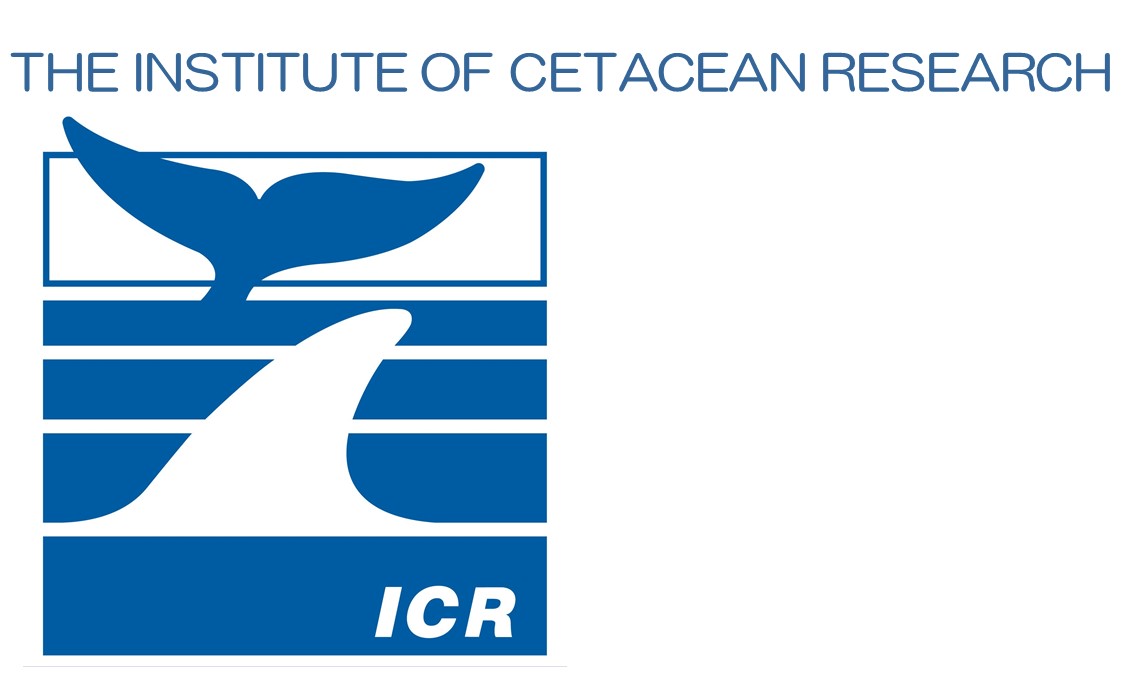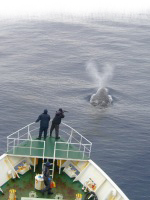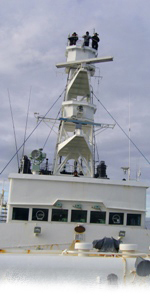Completion of the 2020 IWC/Japan Joint Cetacean Sighting Survey Cruise in the North Pacific
- IWC POWER
September 24, 2020
Designated Corporation for Scientific Whale Research
THE INSTITUTE OF CETACEAN RESEARCH
1. Background
This survey is conducted jointly by the International Whaling Commission (IWC) and Japan, and is commonly referred to as IWC-POWER (International Whaling Commission/Pacific Ocean Whale and Ecosystem Research). IWC-POWER is the successor of IWC/SOWER (International Whaling Commission Southern Ocean Whale and Ecosystem Research), a successful whale research program acclaimed globally, which was conducted in the Antarctic Ocean from 1996/1997 to 2009/2010. Taking advantage of the know-how, experience and achievements of IWC/SOWER, IWC-POWER has been carried out every summer since 2010 based on research priorities of the IWC Scientific Committee.
In the decade leading up to last year, the IWC-POWER research cruises have covered a wide area of the North Pacific that had not been surveyed for a several decades after the adoption of so-called “Moratorium on commercial whaling, finding large numbers of fin and sei whales in the Gulf of Alaska area north of 40 degrees north latitude and a large number of Bryde's whales and sperm whales in waters south of 40 degrees N, and valuable data have been collected to contribute to objective stock assessment. In addition, information on rare species such as blue whales and right whales have also been collected.
As the 11th cruise, this time we conducted a survey of the high seas in the western North Pacific excluding foreign exclusive economic zones within 40 degrees north latitude and between 160 east longitude and 180 degrees. Initially, two U.S. researchers were planned to board the research vessel, but they were unable to participate this year due to restrictions on entry into Japan to prevent the spread of the new coronavirus. For this reason, only Japanese researchers participated in the survey, and the survey was carried out according to the plan without any major problems.
2. Outline of the 2020 Research Cruise and Summary of Results
The 2020 IWC-POWER research cruise was conducted collaboratively by the IWC and the Government of Japan. The IWC Scientific Committee has developed the research program and established the IWC-POWER Steering Group (Convenor: Koji Matsuoka, Head, Stock Assessment and Management Division, ICR), which has a role of designing the research plan and analyzing the results of the cruises. The Institute of Cetacean Research, under the commission of the Fisheries Agency of Japan, carried out the survey in cooperation with various research organizations including the Fisheries Resources Research Institute, Japan Fisheries Research and Education Agency, the Tokyo University of Marine Science and Technology and NOAA/NMFS, USA.
This year's survey plan outline and summary of results are as follows. The results are compiled as of 14 September 2020. Many fin, sei, humpback and sperm whales were sighted in the research area, again suggesting the robustness of the stocks. In particular, a large number of blue whales were sighted in the latter half of the survey, suggesting that the stock is recovering well. On the other hand, no right whales were sighted. In addition, individual identification photographs were taken and biopsy samples were collected for DNA analysis.
Details of the survey results will be presented at next year’s IWC Scientific Committee annual meeting and other scientific meetings.
2.1 Main objectives
(1) Collection of information for the in-depth stock assessment of sei whales, humpback whales and gray whales.
(2) Collection of information on the rare western North Pacific right and blue whales.
(3) Collection of data on abundance and stock structure of other whale resources with insufficient resource information.
(4) Collection of information necessary for the development of medium-to long-term plan of this research program.
2.2 Research Cruise Period
From July 11 to September 24, 2020 (76 days).
2.3 Research Area
Waters excluding foreign exclusive economic zones north of 40 degrees north, east of 160 degrees east longitude and west of 180 degrees (Figure 1).
In the middle of the survey, we called at Kushiro Port to get on board international researchers, equipment and to refuel.
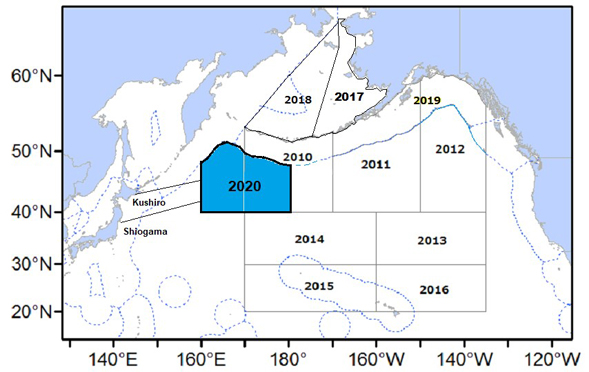
Fig. 1. 2020 IWC-POWER survey area (blue).
2.4 International Researchers
Cruise first half (11 July - 17 August):
Koji Matsuoka (Cruise leader, Institute of Cetacean Research, Japan)
Isamu Yoshimura (IWC-nominated international researcher, Japan)
Taiki Katsumata (Institute of Cetacean Research, Japan)
Cruise second half (20 August - 24 September):
Hiroto Murase (Cruise leader, Tokyo University of Marine Science and Technology, Japan)
Taiki Katsumata (Institute of Cetacean Research, Japan)
Soya Fujii (Tokyo University of Marine Science and Technology, Japan)
2.5 Research Vessel
Yushin-Maru No. 2, (747 ton, Captain Nobuo Abe, 17 crewmen)
2.6 Total Distance Covered
2,424.1 nautical miles (approximately 4,489 km)
2.7 Main whale sightings
Blue whale (22 groups, 31 animals), fin whale (29 groups, 32 animals), sei whale (131 groups, 181 animals), Bryde's whale (6 groups, 8 animals), humpback whale (7 groups, 8 animals), Common minke whale (3 groups, 3 animals), sperm whale (56 groups, 90 animals), killer whale (18 groups, 71 animals).
2.8 Results of sample collections, etc.
(1) Photo identification data (number of individuals)
Blue whale: 26 animals, fin whale: 1 animal, humpback whale: 3 animals, killer whale: 19 animals (total 49 individuals).
(2) Collection of biopsy samples (number of individuals)
Blue whale: 13 animals, fin whale: 9 animals, sei whale: 38 animals, Bryde's whale: 1 animal, humpback whale: 2 animals, killer whale: 2 animals (total 65 individuals).
(3) Whale sound recording
We did not conduct whale sound recording because the U.S. experts in charge were unable to board the research vessel this time.
Photographs from the 2020 IWC-POWER cruise
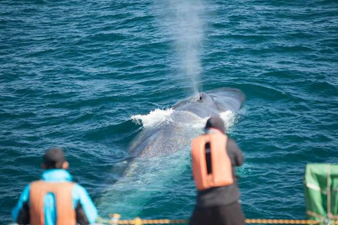 |
 |
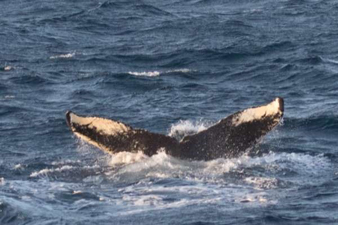 |
| Biopsy sample collection from blue whale | Biopsy sample collection from sei whale | Humpback whale caudal fin (ventral side) |
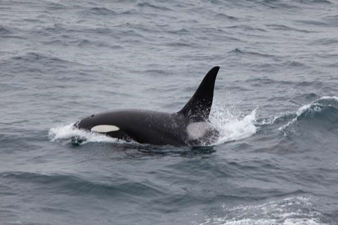 |
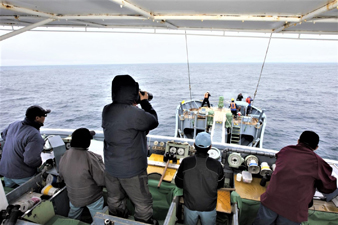 |
 |
| Killer whale dorsal fin | View of a biopsy sample collection experiment from the upper bridge | Yushin-Maru No. 2 crewmen and researchers (Kushiro Port) |
Completion of the 2020 IWC/Japan Joint Cetacean Sighting Survey Cruise in the North Pacific - IWC-POWER (PDF file)
